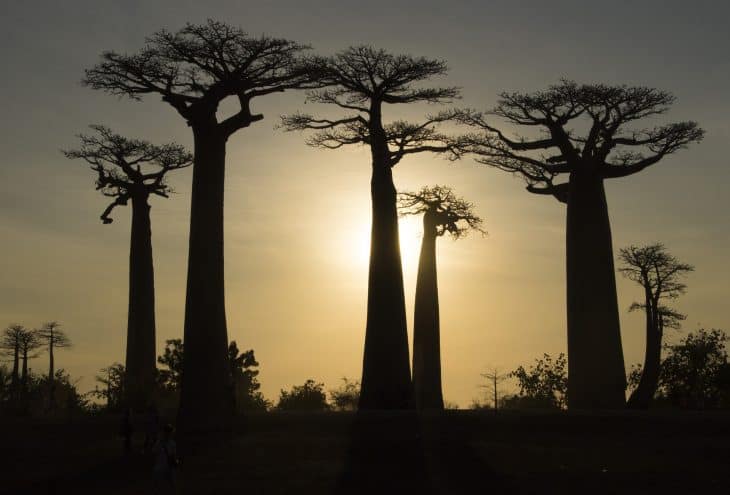
Madagascar, an island nation off Africa’s southeastern coast, is a land of unparalleled biodiversity and rich cultural history. Known for its unique wildlife, such as lemurs and chameleons, as well as its distinct traditions, Madagascar offers a glimpse into a world like no other. The island’s mix of influences, from African to Austronesian, has shaped its people, language, and customs, making it a truly fascinating place. Below are 50 intriguing facts about this remarkable island.
Geography and Nature
- Madagascar is the fourth largest island in the world.
- It’s located in the Indian Ocean, about 400 kilometers off the coast of East Africa.
- The island has a unique biodiversity, with about 90% of its wildlife found nowhere else on Earth.
- Madagascar has two distinct seasons: a hot rainy season and a cooler dry season.
- The highest point in Madagascar is Maromokotro at 2,876 meters above sea level.
- Baobab trees, iconic to Madagascar, can grow over 30 meters tall.
- The island is home to over 70 species of lemurs, the most in the world.
- Madagascar’s coastline stretches over 5,000 kilometers.
- It has one of the largest coral reef systems in the world, known as the Toliara Reef.
- Madagascar has over 3,000 endemic species of butterflies.
History and Culture
- Madagascar was settled by Austronesian peoples around 2,000 years ago.
- The Malagasy people are descendants of both Austronesian and Bantu settlers.
- Antananarivo is the capital and largest city of Madagascar.
- The island gained independence from France in 1960.
- The Malagasy language belongs to the Austronesian language family.
- French is also an official language in Madagascar.
- Madagascar’s flag consists of three colors: red, white, and green.
- The traditional music of Madagascar, called “salegy,” blends African, Indonesian, and European influences.
- The annual Famadihana festival involves exhuming the dead and celebrating with them.
- Zebu, a type of cattle, play an important role in Malagasy culture and economy.
Wildlife and Environment
- Madagascar is known for its chameleons, with over half of the world’s species found here.
- The fossa, Madagascar’s largest carnivore, resembles a small cougar.
- Madagascar’s rainforests are home to the indri, the largest living lemur species.
- The island is also home to the world’s smallest chameleon, Brookesia micra.
- Tenrecs, small mammals resembling hedgehogs, are only found in Madagascar.
- The aye-aye lemur, with its long middle finger, is considered one of the most unusual primates.
- The Madagascar hissing cockroach is famous for its unique sound.
- Madagascar is part of the Madagascar and Indian Ocean Islands biodiversity hotspot.
- Approximately 60% of Madagascar’s original forests have been lost due to deforestation.
- The Malagasy giant rat, or votsotsa, can leap up to three meters in a single bound.
Economy and Resources
- Agriculture is the backbone of Madagascar’s economy, employing about 80% of the population.
- Madagascar is one of the world’s largest producers of vanilla.
- The country also produces large quantities of coffee, cloves, and ylang-ylang.
- Madagascar’s mining sector is growing, with sapphires and other precious stones playing a significant role.
- The Malagasy currency is the ariary.
- Tourism is an important source of income, with many visitors drawn to its unique wildlife and landscapes.
- Rice is a staple food, and terraced rice paddies are common in the central highlands.
- Fishing is vital to coastal communities, contributing significantly to their livelihood.
- Madagascar exports seafood, including shrimp and tuna, to international markets.
- The island has significant untapped oil and natural gas reserves.
People and Traditions
- The Malagasy people have a system of social hierarchy called “foko,” which is similar to clans.
- Malagasy funerals are elaborate, lasting several days and involving large feasts.
- Zebu sacrifices are common during significant ceremonies, including weddings and funerals.
- A traditional Malagasy proverb says, “Water is life, but rice is life-giving.
- The Malagasy have a deep respect for their ancestors, believing they influence daily life.
- Fady, or cultural taboos, vary across the island and dictate many aspects of Malagasy life.
- The Malagasy people celebrate their Independence Day on June 26.
- The Malagasy alphabet consists of 21 letters, as it lacks C, Q, U, W, and X.
- The Madagascar hissing cockroach is sometimes kept as a pet due to its unique behavior.
- Malagasy cuisine often includes a rice dish called “romazava,” which is cooked with greens and beef.
Final Word
Madagascar stands out as a land where nature and culture blend in extraordinary ways. Its unique species, breathtaking landscapes, and deep-rooted traditions make it an unforgettable destination. From its ancient settlement by Austronesian people to its modern economy reliant on vanilla and gemstones, Madagascar’s story is as complex as it is captivating. Whether it’s exploring its diverse ecosystems or learning about the island’s customs, Madagascar has something to offer every curious traveler and nature enthusiast.
Was this page helpful?
Our commitment to delivering trustworthy and engaging content is at the heart of what we do. Each fact on our site is contributed by real users like you, bringing a wealth of diverse insights and information. To ensure the highest standards of accuracy and reliability, our dedicated editors meticulously review each submission. This process guarantees that the facts we share are not only fascinating but also credible. Trust in our commitment to quality and authenticity as you explore and learn with us.
